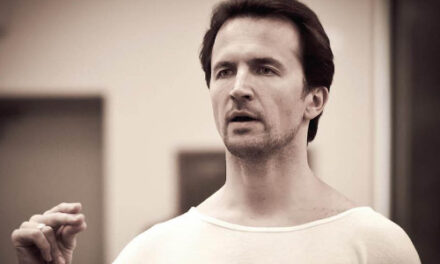Lights up on the controlled chaos of an artist’s mind.
The studio – dimly lit, intentionally refuting natural sunlight – is dingy and cluttered. There are a multitude of buckets full of paint, jars of powered pigment, and dirty rags thrown about. The floor is color-splattered, while every table is at capacity with soaking brushes and coffee cans of cloudy water, or they are stacked high with vinyl – exclusively Classical – for the always in rotation record player. For good measure, Scotch bottles and cigarette butts sit comfortably in the filth of any remaining flat surface.
It is the vastness of the paintings, however, hoisted by large industrial easels around the room, which command attention. Their abstract squares of reds, browns, and blacks bleeding into one another, are cohesive as a collection, yet profoundly distinctive. They “pulsate.” The disarray of the studio is their comfort. They are in sanctuary.
The set (designed by Junghyun Georgia Lee) of Triad Stage’s production of Red at Hanesbrands Theatre is an evolving metaphor. It becomes a way of life, a battlefield, a space for ideation, and in some regards, a piece of art itself.
Therefore, as the audience sits at the top of curtain trying to digest all that’s visually stimulating, they are not alone. There is a man, presumably Mark Rothko (Ned Van Zandt), dressed casually and paint stained, positioned center stage staring out – just short of the audience – at an invisible canvas. He is so immersed in the world of the painting that when young Ken (Craig De Lorenzo) enters the room, he hardly breaks his gaze. Instead, Rothko motions for him to join, and for a moment, everyone in the theatre lets the presence of Art wash over them.
Finally Rothko breaks the silence. His words will be a recurring motif of the evening. Turning to Ken, he asks with urgency, “What do you see?”
John Logan’s Tony Award-winning play, directed by Jeffery West, is intelligent theatre at its finest. It follows Mark Rothko, highly renowned abstract expressionist painter, as he is lucratively commissioned to deliver a series of pieces for the new Four Seasons restaurant in New York City. He employs a naïve and youthful protégé to aid him in the process. Over the span of two years, the men engage in fierce philosophical debate and passionate self-discoveries, all while pondering the nature of art.
Logan’s two-person drama, although at times indulgent with highbrow art aficionado-isms, is richly packed with eloquently driving dialogue. The monologues that both characters deliver are often reminiscent of stimulating academic lectures and rousing revolutionary soapboxes. It is profound, thought provoking, and requires audiences to self reflect on how one experiences the world. In many ways, Logan has constructed his own interpretation of Plato’s Socratic dialogues, with the tortured genius of Mark Rothko as a backdrop.
In life, Rothko was known for his brash and debatably pretentious views of society and artistic expression. Heavily influenced by Friedrich Nietzsche’s The Birth of Tragedy, most of his collection of work dealt with the navigation of man’s spiritual emptiness. The colors, especially their contrast, were strategically chosen to convey a wide range of emotions, particularly despair and hope, and how they battle to be understood. Some hold that Rothko, who committed suicide in 1970, suffered from an undiagnosed bipolar disorder.
Van Zandt’s volcanic portrayal of the artist is an esteemed accomplishment. He was able to tap into the core of this deeply complex man, preserving his integrity, all the while subtly revealing his emotional despondency. The character requires a sense of narcissistic dominance, which Van Zandt executed flawlessly.
As Ken, De Lorenzo mastered the challenging feat of being submissive onstage without once making the character small. His fresh energy was the ideal juxtaposition to the aging stubbornness of the Rothko character. There was an apparent maturing as the play ensues, with De Lorenzo locking into the emotional build. Therefore, in climatic moments, he was convincingly able to stand his ground with affective potency.
Both actors personified the foremost doctrine of Mark Rothko’s use of contrasting shapes and colors. What he conveyed through abstract expressionism, this production did with theatre. There was the new slowly dethroning the old, and Light being chased out by Darkness.
In a moment of unguarded honesty after a heated exchange about how the color red captures the essence of life itself, Rothko quietly reveals to Ken, “There is only one thing I fear in life, my friend…One day the black will swallow the red.”
With this in mind, if at the end of the production the character were to stand before the audience, gazing out as he did at the start and ask again, “What do you see?” it would not be without warrant or honesty that the audience would respond…
“Red.”
Red continues through Sunday, February 23. For more details on this production, pelase view the sidebar.











